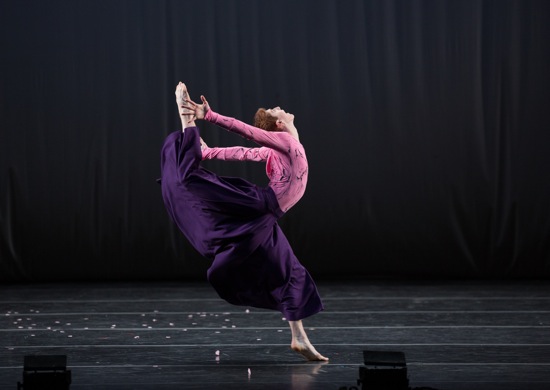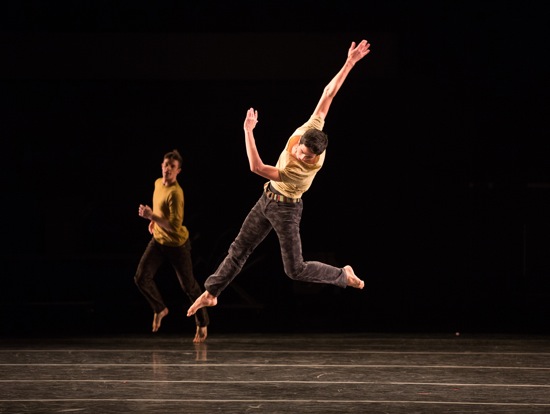Juilliard students appear in premieres by Takehiro Ueyama, Brian Brooks, and Darrell Grand Moultrie, plus a reconstruction of a work by Pina Bausch.
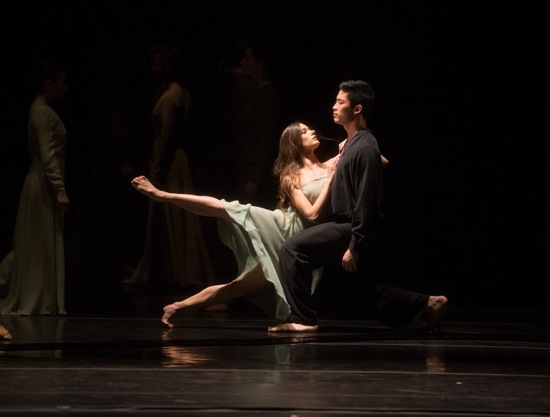
Fourth-year Juilliard students Kristina Bentz and Bynh Ho in Pina Bausch’s Wind von West. Photo: Rosalie O’Connor
Every winter, the Juilliard School presents its dance students in four new works. All its dance students. Although—since some pieces are double cast—you might have to attend two performances to see every single talented dancer on stage. This year, from December 11 through 15, Takehiro Ueyama displayed the dance department’s first-year students in his Nakamura; Brian Brooks took on the second-year dancers in Torrent; and the third-year students performed Darrell Grand Moultrie’s Seeds of Endurance. The 2013 edition of New Dances, however, had to be titled New Dances PLUS, because the 2014 graduating class is performing a revival, and a very important one: Pina Bausch’s Wind von West.
Tanztheater Wuppertal, Bausch’s company, premiered Wind von West (Wind from the West) on December 3, 1975, along with her great Rite of Spring and a smaller-scale dance, Der zweite Frühling (The Second Spring)—all set to music by Igor Stravinsky. The entire program was revived in Wupptertal and presented this past November to celebrate the 40th anniversary of the company that the late choreographer founded.
The revival also marked a coming together of Juilliard’s senior class and students at the Folkwang University of the Arts in Essen (Bausch herself studied at both institutions), as part of the TANZFONDS ERBE Project directed by Bausch veteran Dominique Mercy. Both groups were meticulously coached in Wind von West by Josephine Ann Endicott, who danced its leading role in 1975; Mari DiLena, who understudied her; and John Giffin, another former member of Tanztheater Wuppertal, who performed in it later. Eight Juilliard dancers traveled to Wuppertal to appear in the revival, and seven Folkwang dancers joined the New York cast.
Wind von West is set to Stravinsky’s Cantata (1952), written for soprano, tenor, a female chorus of four, two flutes, oboe, English horn, and cello. At Juilliard—oh joy!—it was played live by Juilliard students and graduates under the baton of Yuga Cohler. The text is composed of anonymous early English songs, with verses of a dirge that warn of purgatory threading through it. Stravinsky made the familiar, tuneful “Tomorrow shall be my dancing day” (Jesus is the speaker) simmer with bitter or questioning dissonances. And the heart-breakingly succinct poem “Westron Wind” becomes a fierce contrapuntal duet for tenor and soprano above galloping eighth notes (in its entirety: “Western wind, when wilt thou blow, [that] the small rain down may rain? Christ, if my love were in my arms and I in my bed again!”).
In 1975, Bausch had not yet ventured into the speaking and singing that infused her later works. Wind von West (on which she was assisted by Hans Pop) is a beautiful and mysterious choric dance that could be a woman’s dream or a journey through layers of memory. The set by Rolf Borzik (Bausch’s collaborator and partner until his death in 1980) consists of two scrims that divide the stage horizontally into three “rooms.” To go from one room to another, performers open doors (also made of scrim) on either edge of the stage. Several times, the ensemble of 19 fills all three areas (the cast includes three Folkwang dancers and one or two from Juilliard’s class of 2015).
In this haunting and haunted world, we see a woman (Kristina Bentz on opening night) in a long, unadorned silk gown and construe her as the dreamer or heroine. In the middle “room,” there is a bed; high and white-sheeted, it resembles a hospital gurney. Although the woman lies down on it later, while two men seem to mourn or comfort her, and although at the end of the piece, she is curled up on it, when the curtain opens, the bed is empty, and she is on the floor near the audience, sitting with her legs stuck out in front of her like a doll. Yet other women, also dressed in long gowns, surround the bed—now bending low, now stretching up their arms, as if in grief.
Two women could represent a mother and child. The taller of the pair (Taylor Drury), reclining on the floor, makes her body into a cradle for the smaller woman (Tsai-Wei Tien)—rocking her quietly, folding her into an embrace, then stretching out with her again. For a few seconds, Bentz breaks off her dancing to insert herself into their hug, as if she were—or had been–part of this family. Two men figure importantly in the elusive scenario. One, dressed in back, (Bynh Ho) is grave and almost stoic; holding her, manipulating her, seeking her out, he could be a lover or a father or both. The other man (Shan Gao) wears only briefs and spends a number of minutes at the beginning and end of Wind von West standing in a glowing pool of light in the most distant zone, his back to the audience. Gao (one of the Folkwang guests) is as flexible and as ardent in his dancing as Bentz, and a lyrical, almost unearthly presence. Another woman (Linda Pilar Brodhag) intermittently touches the lives of the others in unobtrusive ways.
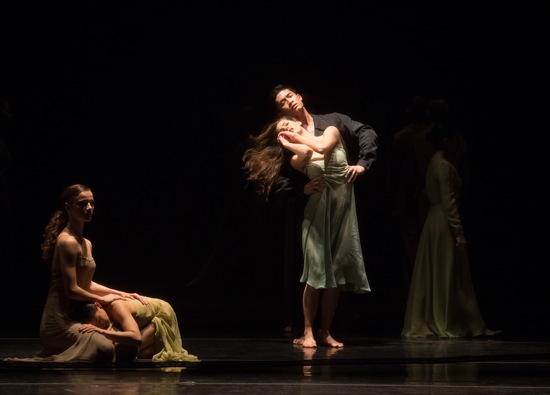
(L to R): Taylor Drury, Tsai-Wei Tien, Kristina Bentz, and Bynh Ho in Wind von West. Photo: Rosalie O’Connor
You sense the importance of certain details without understanding what they mean. Early on, standing by the bed, Bentz (a beautiful and expressive dancer) takes down her hair, and, as she dances, it lashes about her, often obscuring her face. At one point, the men of the ensemble enter and shake the women in the group. Gestures associated with prayer appear and ones in which each dancer raises a curled hand to her cheek, perhaps to blot a tear.
In this strange, dream-like atmosphere, the performers often wait, holding a pose, as the voices of Avery Amereau and/or Miles Mykkanen or the four women flow on, telling of love and death. Sometimes the ensemble dancers rush onto the stage as if coming to a gathering, but instead become a kind of angelic chorus; spreading their arms like wings and gazing upward, bending fluidly like a field of wheat in the wind, they also absorb some of the heroine’s gestures.
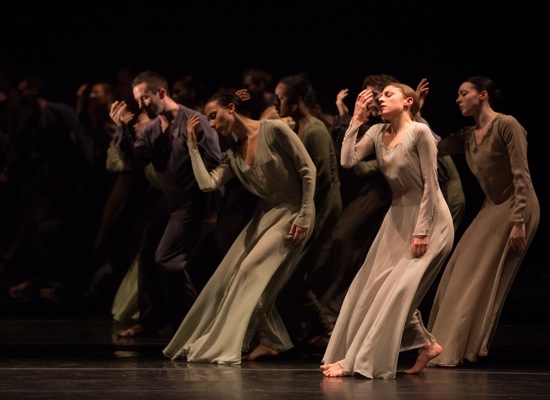
The ensemble in Wind von West: (Foreground, L to R): Magdalyn Segale and Linda Pilar Brodhag. Photo: Rosalie O’Connor
The dancers are marvelous in their sensitivity to this dark, veiled, but luminous world they travel through. The choreography requires them to be fluid yet precise, gentle yet extravagant, and all of them—from ensemble members to leading dancers—enter it with full commitment. The solo that Bentz performs (as do Daphne Fernberger and Folkwang guest Luiza Braz Batista at other performances) is reminiscent of what Bausch herself did in her 1978 Café Mueller. This woman arches her back, opening her body to whatever fate may bring, but she also wreathes her arms around her head and torso, as if to protect or comfort herself. Sometimes her movements seem to be a visualization of weeping—her lifted arms falling softly and helplessly. Like tears.
Wind von West, however, is not lugubrious. Both Stravinsky’s music and Bausch’s choreography are full of questions and possibilities. The dissonances are more wistful than aggressive. Not all members of the class of 2014 got to show off their physical virtuosity in Wind von West, but they played a vital part in the miraculous resurrection of an almost forgotten masterwork.
Wind von West ended the programs (ordered as usual with the youngest students on view first). It’s interesting to see how they develop over their four years at Juilliard, but all are gifted—some astonishingly so. It’s not so much that they gain in technical chops as they go, but how they learn to modulate and shape their dancing. Too, the artistic director of Juilliard Dance, Lawrence Rhodes, is usually astute in picking out choreographers who will both challenge and showcase them appropriately.
Ueyama, who danced with Paul Taylor’s company for eight years and founded his own group, TAKE, in 2005, created Nakamuraya in honor of his favorite Kabuki star, Nakamura Kanzaburo XVIII. This homage gave him permission to create a patchwork quilt of images relating to aspects of the performer’s life and to use a variety of recorded music that includes a fast movement from a Mozart Divertimento, Japanese selections, and Lou Reed singing “Perfect Day.” At first, Nathan Carter, wearing a long skirt, is idolized by a motley group of fans with cell-phone cameras; they peek under his costume, jump on him, and hoist him like a doll. Spotlit Evan Fisk makes his hand flutter while fireflies of light respond (lighting by Nicole Pearce); his “perfect day” is made by the arrival of Eliza Lanham. There are banging drums, flashing lights, stomping women, leaping men, some very handsome (if not intensely musical) movement, and lots of running around.
In Torrent, Brooks presents the 24 second-year students in a more formally composed piece; it’s both astringent and sensual, as befits a dance set to music by Max Richter that channels Vivaldi. For a while Brooks plays with lines. Dancers assemble shoulder to shoulder, then peel off one by one and run back into the wings. A major line includes all the dancers, and they make it turn like a giant wheel; its circumference fills the stage. At a later point, lines become porous, and the performers do more than make linear designs. In small units, they turn, duck under, and reach around one another, giving the impression of evolving microcosms. When not engaging in Brooks’s fluid, springy athletics, dancers pair up to engage in scalloping, scooping arm gestures that move evasively around like slippery conversations. Accumulating and de-accumulating personnel, Torrent does indeed swell richly from the modest stream of its beginning before receding into darkness.
Costume designer Fritz Masten, like lighting designer Pearce, does triple duty on the program. And he outdoes himself for Moultrie’s Seeds of Endurance. The women in the cast of 27 wear long, full-skirted, flesh-colored dresses (darker-skinned dancers wear a subtly darker hue—a thoughtful idea); these are split in front to reveal red underskirts. When the women dance vigorously together, the effect is almost distracting, but the flashing, thrashing glimpses of red make the dancers look like bright birds showing their mating readiness. I’m not sure what the title of the piece means, but the performers tear around, have near collisions, and, when some of them sit down, others drag them away.
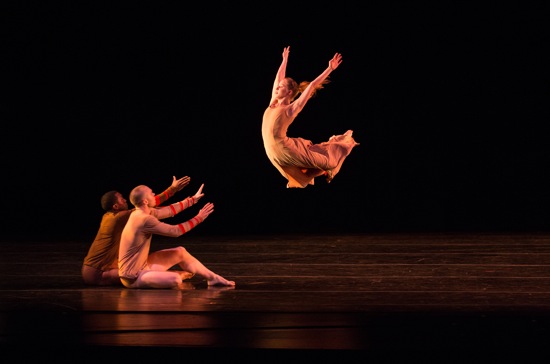
(L to R): Jeremy Coachman, Jordan Lefton, and Solana Temple in Darrell Grand Moultrie’s Seeds of Endurance. Photo: Rosalie O’Connor
At time they stop in their kicking and leaping and stare at us. They let us hear them breathe—faster and faster. The music, as in Ueyama’s piece is eclectic—selections by Ezio Boss and Kenji Bunch. Toward the end, one woman crawls on, and a few of the others back away. They feel their own bodies and those of others. Are they coming down with something? Or have they endured something? Moultrie is a Juilliard graduate and a busy choreographer, but I’m not sure what to make of this work. The dancers gave it their considerable all.


